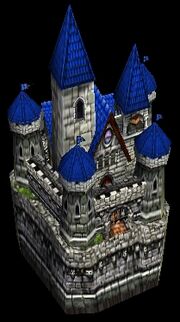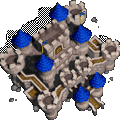DarkTichondrias@legacy41533789 (talk | contribs) (RECAT unit 1st name) |
m (→In Warcraft II) |
||
| (38 intermediate revisions by 15 users not shown) | |||
| Line 1: | Line 1: | ||
| − | [[ |
+ | [[File:Stormwind Keep.jpg|thumb|Stormwind Keep]] |
| + | [[Image:Castle-red.jpg|thumb|Human castle of the Third War.]] |
||
| − | The '''Castle''' helped the [[High Elf|High Elves]] fend off Arthas as he tried to attack their capital [[Silvermoon]] and [[Quel'thalas]] in Warcraft III by serving as a returning point for gold and training units. The [[Blood Elf|Blood Elves]] use a different Castle that produces differnt units in the Frozen Throne Expansion Campaign in Warcraft III. It is the upgraded version of the [[High Elf Town Hall|Town Hall]]. It cannot be built by the "[[High Elf Worker|High Elf (Worker)]]" probably due to the limited ability of the map editor prior to the Frozen Throne Expansion. With the Frozen Throne Expansion map editor, it is possible to make additional groups with building orders. |
||
| + | |||
| ⚫ | |||
| + | A '''castle''' is a [[keep]] usually surrounded by a 15-foot stone wall with four [[tower]]s. Huge castles have a particularly large keep with numerous associated buildings ([[stable]]s, [[forge]], and the like) and an elaborate 20-foot high wall creating a [[wikipedia:Bailey|bailey]] and courtyard areas. The wall has six towers. Castle walls are usually ten feet thick.<ref>[[World of Warcraft: The Roleplaying Game]], pg. 202.</ref> Castles are the centers of some of the largest [[human]] [[cities]]. |
||
| + | |||
| + | In the Warcraft RTS games, castles are upgrades to keeps. |
||
| + | |||
| + | == Human castles == |
||
| + | The mighty castles of [[Lordaeron]] are the center of large military cities. As with the lesser keeps, [[peasant]]s may bring gold and lumber here for judicious dispersal in order to sustain the war effort. These bastions against invasion are guarded by fortified battlements, making them virtually indestructible. The castle represents the strength of the peoples of the [[Alliance]] and their unyielding resolution to defend the whole of [[humanity]] against the [[Orcish Horde]]s.<ref>[[Warcraft II manual]], pg. 57.</ref> |
||
| + | |||
| + | Castles represent the pinnacle of advanced human civilization. With this advancement comes the ability to support stables for housing the war-steeds of the heroic [[knight|knights]]. This progression also allows the building of gryphon aviaries.<ref>[[Waecraft III manual]], pg. 76.</ref> |
||
| + | |||
| + | In Warcraft III, [[high elves]] and [[blood elves]] used castles similar to the human castles. |
||
| + | |||
| + | == In World of Warcraft == |
||
| + | {{WoW}} |
||
| + | |||
| + | In ''World of Warcraft'', the only human castles are the [[Ruins of Lordaeron]] and [[Stormwind Keep]] (the [[castle]] had been raised upon the foundations of the old keep, but kept the name.{{Cite|W2}}{{Fact}}) [[Sunfury Spire]] may be thought of as a blood elven castle. |
||
| + | |||
| ⚫ | |||
| + | {{col-begin}} |
||
| + | {{col-3}} |
||
| + | ===Alliance [[castle]] stats=== |
||
| + | * 2500 HP |
||
| + | * 5 fortified armor |
||
| + | * Trains [[Peasant]] |
||
| + | {{col-3}} |
||
| + | ===High Elves castle stats=== |
||
* 2500 HP |
* 2500 HP |
||
* 5 fortified armor |
* 5 fortified armor |
||
* Provides 50 food |
* Provides 50 food |
||
| ⚫ | |||
| − | * Trains |
||
| + | {{col-3}} |
||
| ⚫ | |||
| + | ===Blood Elves castle stats=== |
||
| + | * 2500 HP |
||
| + | * 5 fortified armor |
||
| + | * Provides 12 food |
||
| + | * Trains [[Blood Elf Engineer]], [[Blood Elf Worker|Worker]] |
||
| + | {{col-end}} |
||
| + | ==In Warcraft II== |
||
| + | * 1600 HP |
||
| + | * Provides 1 food |
||
| + | * Trains [[Peasant]] |
||
| + | |||
| + | ==Gallery== |
||
| + | <gallery> |
||
| + | File:Castle.jpg|Blood elf and high elf castles. |
||
| + | File:Lordaeroncity.jpg|Lordaeron's castle |
||
| + | File:HumanCastle.gif|Human castle of the Second War. |
||
| + | File:Sunfury Spire.jpg|Sunfury Spire |
||
| + | </gallery> |
||
| + | ==References== |
||
| + | {{Reflist}} |
||
| + | {{Warcraft II buildings}} |
||
| − | [[Category:Elves]] |
||
| + | {{Warcraft III buildings}} |
||
| − | [[Category:High Elf|Castle, High Elf]] |
||
Revision as of 12:59, 21 March 2010

Stormwind Keep

Human castle of the Third War.
A castle is a keep usually surrounded by a 15-foot stone wall with four towers. Huge castles have a particularly large keep with numerous associated buildings (stables, forge, and the like) and an elaborate 20-foot high wall creating a bailey and courtyard areas. The wall has six towers. Castle walls are usually ten feet thick.[1] Castles are the centers of some of the largest human cities.
In the Warcraft RTS games, castles are upgrades to keeps.
Human castles
The mighty castles of Lordaeron are the center of large military cities. As with the lesser keeps, peasants may bring gold and lumber here for judicious dispersal in order to sustain the war effort. These bastions against invasion are guarded by fortified battlements, making them virtually indestructible. The castle represents the strength of the peoples of the Alliance and their unyielding resolution to defend the whole of humanity against the Orcish Hordes.[2]
Castles represent the pinnacle of advanced human civilization. With this advancement comes the ability to support stables for housing the war-steeds of the heroic knights. This progression also allows the building of gryphon aviaries.[3]
In Warcraft III, high elves and blood elves used castles similar to the human castles.
In World of Warcraft
Template:WoW
In World of Warcraft, the only human castles are the Ruins of Lordaeron and Stormwind Keep (the castle had been raised upon the foundations of the old keep, but kept the name.Template:Cite[citation needed] ) Sunfury Spire may be thought of as a blood elven castle.
In Warcraft III
-
Template:Col-3
- 2500 HP
- 5 fortified armor
- Trains Peasant
- 2500 HP
- 5 fortified armor
- Provides 50 food
- Trains High Elf (worker)
- 2500 HP
- 5 fortified armor
- Provides 12 food
- Trains Blood Elf Engineer, Worker
Alliance castle stats
Template:Col-3
High Elves castle stats
Template:Col-3
Blood Elves castle stats
In Warcraft II
- 1600 HP
- Provides 1 food
- Trains Peasant
Gallery
- Lordaeroncity.jpg
Lordaeron's castle
References
- ^ World of Warcraft: The Roleplaying Game, pg. 202.
- ^ Warcraft II manual, pg. 57.
- ^ Waecraft III manual, pg. 76.
| |||||||||||||||||



